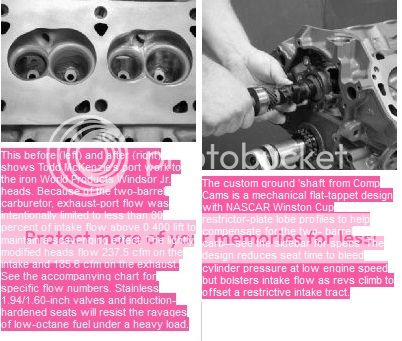You have to see where your heading, using past precedents, then forwarding actions, then review that its done. Richard, your really looking at a T-code 200 Sprint engine with a special 2v carb, headers, cam/head/valve mods to get past the poor exhast flow.
Lets recap on a 352 hp net at 6700 rpm /316 lb-ft at 5000rpm C-code based 2-bbl 289 with K-code solid lifter cam, and show what a soft head/NASCAR restrictor plate tune would be like to draw out power and torque which tecnically wouldn't be there considering the carburation to cube ratio and air flow readings. Once that's pulled apart and understood, apply the concept to a 200 or 250.
Stock 2-bbl 289 power was rated back in the day as 195 hp gross, but was probably 156 hp at 4400 rpm, stock torque was most likely 225 lb-ft at 2800 rpm. Compression was about 9.2:1, which is elevated to 9.25:1 for his engine. It uses stock 2-bbl 2300 series #4412 Holley 500 cfm with 1.375" venturis, and stock 73 jets and two stock 62.5 thou power valve channel restrictions for this new found power. That means that the carb is being sucked within an inch of its life at 6700 rpm for its 293 cubes and at 85% VE, the carb 'sees' 482 cfm. Stock was the 2-bbl 2100 Autolite 1.14 = 300cfm, 1964 - '67, on 289's
Vizard and others use traditional power predictions that take peak head flow at 10, 25, or 28 inches on a standard piston size of 500 cc for 4 cyl, 625 cc for a 5 liter /305 cid engine, multiply by a factor, and thats your maximum power. A scala factor is applied to correct for engine sizes above or below. A 293 cub engine making 237.5 cfm at 28 inches can make 450 hp at 8500rpm if there is no choke point. For an all encompassing link, see
http://www.wallaceracing.com/calcafhp.php
Now, the last kicker was the heads were based on a 237.5 intake, 185.6 exhast, and "because of the two-barrel carburetor, exhaust-port flow was
intentionally limited to less than 80 percent of intake flow above 0.400 lift to maintain a scavenging effect. Read more:
http://www.hotrod.com/techarticles/engi ... kYG0GTeI80%" Itallics mine, and its all based on 1.94 intake /1.60 exhast.
The intake manifold, a single plane Edelbrock Victor Jr. intake with an adapter that's hogged to match the carbs bore size, is one of the best, so its not really feasible to copy it on a small six. It's like comparing a two hole 1.675" discharge to a nice square verses one 1.75" hole to a rectangle.
So running the numbers, we have a 289 V8 making really good power very high up in the rev range, and, at just over an lb-ft per cube, quite poor torque at 316 lb-ft. Scaled down to a 200 with 1.75" intakes and 1.45" exhasts, that's 244 hp and 219 lb-ft. Due to poor head flow and limited carburation, torque and hp occur at too high an rpm.
Back tracking to an EFI 3.3 non crossflow Holden engine in 1985, it had 195 lb-ft at 3000 rpm, and 142 hp at 4800 rpm, with a 264 degree cam with 8.8:1 compression. 1.625" intakes, 1.4" exhasts, 12 port head with similar head flow to a D7 head. Still less than 1 lb-ft per cube. A 250 EFI Falcon with 8.8:1 compression, 264 cam, 247 lb-ft, or less than one lb-ft per cube at 3000 rpm.
Somewhere between the two is where best low end torque curve lies.
I'd personally like to see 9.7:1 compression, maximum torque at 3500 to 4000 rpm( 207 lb-ft at 4000rpm being possible), power of 193 hp at 5750 rpm, and a 2-bbl 2300 series 350 cfm #7448 carbwith 1.1875" venturis, and a 280 degree cam which produces those figures with a head that meets 80% of the peak intake flow at 360 thou. Based on Wallaces website, which calculated 450 hp at 237.5 cfm, I'd punt for 249 hp flowing heads to get 193 hp. You'd only need 175 cfm at the intake. To get power at 5750 rpm, your internal port size outside the intake valve needs to be only 1.338", and a D7 head is about that already, but the intake runners are too small leading up to that to allow the 1.338 port size to be effective. Thats why people favour the large runner intake manifold, as the ports then have a chance to get good air flow from the carb.
With that combo, you'd still get power, but get excellent lower speed torque.

